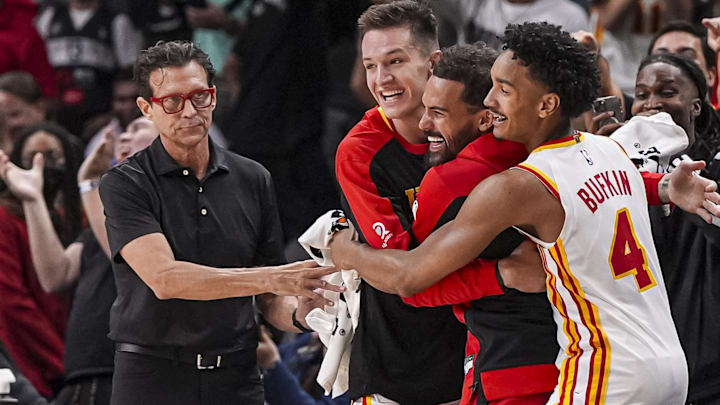The Atlanta Hawks have opened up the NBA offseason with a couple of major bangs. From adding Kristaps Porzingis to fleecing the New Orleans Pelicans, this team continues to throw the rest of the league for a whirl. And thanks to the massive Dejounte Murray traded player exception, they most likely aren’t even done yet.
As part of the deal that shipped Murray to The Big Easy last summer, the Hawks created a traded player exception (TPE) worth nearly $25.3 million. These TPEs can be used to acquire one or more players making up to that amount without having to send anyone else out in return. They can also be paired in tandem with other salaries to limit the amount of additional money the Hawks take on while still saving major dollars for any trade partner.
For example, let’s say Atlanta is willing to ship out Kobe Bufkin’s $4.5 million. Under the current rules for teams beneath the first apron, it could take back another player making around $9.2 million. But because the Hawks have that Murray TPE, they can actually acquire someone making up to $25.3 million—which still saves the other team nearly $21 million in this hypothetical.
This type of flexibility isn’t just convenient. Given the current offseason landscape, it has the potential to change everything.
Only one other NBA team can rival the Hawks’ trade flexibility
Right now, the Brooklyn Nets are the only team with enough spending power to sign or acquire someone making noticeably more than the non-taxpayer mid-level exception of $14.1 million. Add TPEs into the equation, and you get another squad with that capability: The Hawks, and the Hawks alone.
Granted, the Chicago Bulls ($17.2 million) and Sacramento Kings ($16.8 million) have TPEs that come pretty close. But they still don’t sniff Atlanta’s $25.3 million chip.
This tool can allow the Hawks to acquire someone like Trey Murphy ($25 million), Mikal Bridges ($24.9 million), Jaden McDaniels ($23.4 million), Dillon Brooks ($21.1 million), Cam Johnson ($21.1 million), Collin Sexton ($18.9 million), Malik Monk ($18.8 million), and many other impact names without having to send much (or any) player equity back in return.
Sure, Atlanta’s trade partners will need to be compensated, unless they’re sending back unwanted money (think: the Memphis Grizzlies and Kentavious Caldwell-Pope). But the savings that can be offered by the Hawks is a huge asset by itself.
The Hawks have the runway to use this $25 million hack
Now, the Hawks’ own payroll could get in the way of their next move. Assuming they re-sign Caris LeVert to a deal starting at around $15 million, they will be about $15 to $16 million below the tax—a line we shouldn’t expect them to cross, at least for now.
That $15 to $16 million becomes the maximum amount of money Atlanta can add to its payroll. But again, that’s presuming nobody else is part of the trade. Let’s say the Hawks are willing to move Bufkin and Dominick Barlow in the same deal. By shedding their $6.8 million in combined salary, they are suddenly able to take back a player making more than $20 million without entering tax.
The catch of it all: Atlanta needs to use this TPE by July 7, otherwise it expires. But the Onsi Saleh-led front office has already shown it’s ready and willing to make waves. Don’t be surprised if the Hawks swing yet another acquisition that significantly upgrades their rotation—and puts the rest of the NBA on notice.
